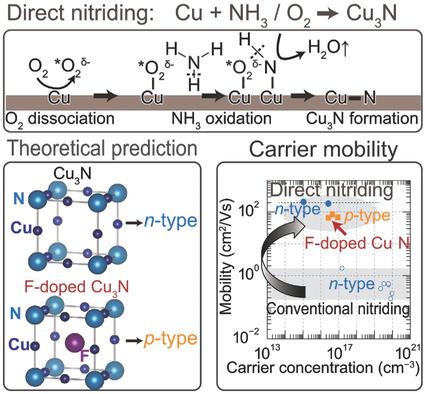当前位置:
X-MOL 学术
›
Adv. Mater.
›
论文详情
Our official English website, www.x-mol.net, welcomes your feedback! (Note: you will need to create a separate account there.)
High‐Mobility p‐Type and n‐Type Copper Nitride Semiconductors by Direct Nitriding Synthesis and In Silico Doping Design
Advanced Materials ( IF 29.4 ) Pub Date : 2018-06-19 , DOI: 10.1002/adma.201801968 Kosuke Matsuzaki 1 , Kou Harada 2 , Yu Kumagai 1 , Shogo Koshiya 3 , Koji Kimoto 3 , Shigenori Ueda 4, 5 , Masato Sasase 1 , Akihiro Maeda 2 , Tomofumi Susaki 1, 2 , Masaaki Kitano 1 , Fumiyasu Oba 1, 2, 6 , Hideo Hosono 1, 2
Advanced Materials ( IF 29.4 ) Pub Date : 2018-06-19 , DOI: 10.1002/adma.201801968 Kosuke Matsuzaki 1 , Kou Harada 2 , Yu Kumagai 1 , Shogo Koshiya 3 , Koji Kimoto 3 , Shigenori Ueda 4, 5 , Masato Sasase 1 , Akihiro Maeda 2 , Tomofumi Susaki 1, 2 , Masaaki Kitano 1 , Fumiyasu Oba 1, 2, 6 , Hideo Hosono 1, 2
Affiliation

|
Thin‐film photovoltaics (PV) have emerged as a technology that can meet the growing demands for efficient and low‐cost large‐scale cells. However, the photoabsorbers currently in use contain expensive or toxic elements, and the difficulty in bipolar doping, particularly in a device structure, requires elaborate optimization of the heterostructures for improving the efficiency. This study shows that bipolar doping with high hole and electron mobilities in copper nitride (Cu3N), composed solely of earth‐abundant and environmentally benign elements, is readily available through a novel gaseous direct nitriding reaction applicable to uniform and large‐area deposition. A high‐quality undoped Cu3N film is essentially an n‐type semiconductor, while p‐type conductivity is realized by interstitial fluorine doping, as predicted using density functional theory calculations and directly proven by atomically resolved imaging. The synthetic methodology for high‐quality p‐type and n‐type films paves the way for the application of Cu3N as an alternative absorber in thin‐film PV.
中文翻译:

通过直接氮化合成和硅掺杂设计实现高迁移率p型和n型氮化铜半导体
薄膜光伏(PV)已成为一项可以满足对高效,低成本大型电池日益增长的需求的技术。然而,当前使用的光吸收剂包含昂贵或有毒的元素,并且双极掺杂的困难,特别是在器件结构中的困难,需要精心优化异质结构以提高效率。这项研究表明,氮化铝(Cu 3 N)中仅由富地球和环境友好的元素组成的具有高空穴和电子迁移率的双极掺杂很容易通过适用于均匀且大面积沉积的新型气态直接氮化反应获得。高质量的未掺杂Cu 3N膜本质上是n型半导体,而p型电导率是通过填隙氟掺杂实现的,如使用密度泛函理论计算所预测并通过原子分辨成像直接证明的那样。高质量p型和n型薄膜的合成方法学为将Cu 3 N用作薄膜PV的替代吸收剂铺平了道路。
更新日期:2018-06-19
中文翻译:

通过直接氮化合成和硅掺杂设计实现高迁移率p型和n型氮化铜半导体
薄膜光伏(PV)已成为一项可以满足对高效,低成本大型电池日益增长的需求的技术。然而,当前使用的光吸收剂包含昂贵或有毒的元素,并且双极掺杂的困难,特别是在器件结构中的困难,需要精心优化异质结构以提高效率。这项研究表明,氮化铝(Cu 3 N)中仅由富地球和环境友好的元素组成的具有高空穴和电子迁移率的双极掺杂很容易通过适用于均匀且大面积沉积的新型气态直接氮化反应获得。高质量的未掺杂Cu 3N膜本质上是n型半导体,而p型电导率是通过填隙氟掺杂实现的,如使用密度泛函理论计算所预测并通过原子分辨成像直接证明的那样。高质量p型和n型薄膜的合成方法学为将Cu 3 N用作薄膜PV的替代吸收剂铺平了道路。



























 京公网安备 11010802027423号
京公网安备 11010802027423号